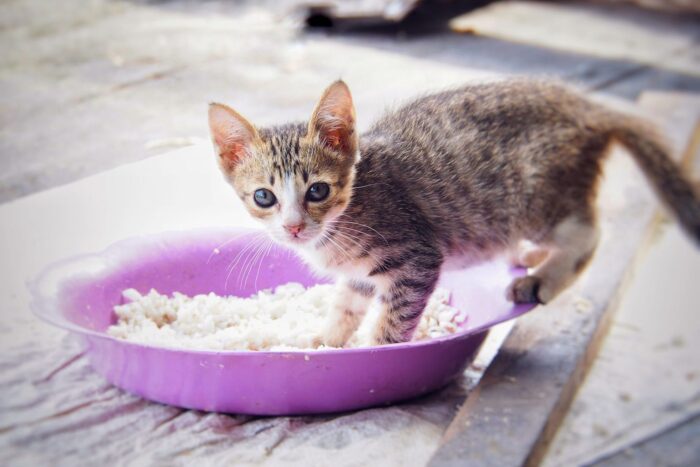As you prepare a savory stir-fry or fluffy pilaf, the smell wafting from the rice pot entices nearby kitties begging for a taste. But is this pantry staple safe for cats to indulge in? Understanding rice’s nutritional pros and cons along with preparation methods allows responsible sharing between humans and hungry pets. In this post we talk about Can Cats Eat Rice.
Rice Nutrition 101
At its most basic level, rice provides a dense source of carbohydrates with a small amount of plant protein. Brown and white varieties differ significantly in fiber content as well as essential vitamins and minerals provided.
During the milling process refining grains down to white rice, the nutritionally-thick outer bran and inner germ get removed, leaving primarily simple starch granules. This makes white rice faster absorbing yet less satiating. Brown rice still retains all nutritional layers, taking slightly longer to break down while delivering more vitamins, minerals and fiber.
For cats, moderate extra carbohydrates pose no major issues nutritional unless comprising a main component of daily calories. Too many carbs too often stresses pancreases and blood sugar regulation over time. So rice rates as an occasional supplement rather than dietary foundation.
Safety Considerations for Cats
The biggest risks feeding cats rice involve:
● Choking on improperly cooked varieties
● Nutrient deficiencies if fed exclusively
● Obesity from excess carbohydrate load
● Gastrointestinal issues if intolerant
Follow preparation instructions properly to allow digestible nutrient absorption and minimize these problems. Most critically, thoroughly cook all rice to soften granules during digestion.
Benefits of Rice for Cats
In moderation, plain rice offers felines certain nutrition advantages including:
● High satiety keeps cats feeling fuller longer
● Low glycemic impact supports steady energy
● Soluble fiber aids healthy digestion
● Probiotic support from fermented rice dishes
● Supplemental protein source for picky eaters
● Gluten-free alternative grain for allergies
● Low sodium content avoids excess like commercial cat foods
● Antioxidants in bran layers reduce cell damage
Essentially rice offers cats a starchy compliment rounding out amino acids from animal protein sources. Mixing a few bites throughout a balanced fresh food diet proves beneficial for most felines.
Transitioning to Rice Gradually
When first introducing rice to your cat’s diet, take things slowly. Start with just a bite or two occasionally to check for digestive sensitivity or allergies. Monitor litter boxes for proper waste consistency, abrasive foot pads from perching to defecate, constipation, vomiting, or irritation around mouths. Discontinue immediately if any inflammation appears.
Cats notoriously resist dietary shifts. But disguising new ingredients mixed thoroughly into favorite recipes helps prevent pickiness. Expect several initial exposures before acceptance, pairing with positive associations like praise and play rewards.
Ideal Serving Sizes
When cats tolerate simple steamed rice well, determine appropriate meal additions based on their size and energy requirements while accounting for all nutritional sources in combination. General guidelines suggest:
● Overweight & Sedentary Cats – Avoid carby rice altogether
● Kittens Under 1 Year – Up to 2 Tablespoons Rice 2-3 Times Weekly
● Lean Adult Cats – Up to 2 Tablespoons Rice 2-4 Times Weekly
● Pregnant/Nursing Cats – Up to 1⁄4 Cup Cooked Rice Per 5 lbs Body Weight Daily
Adjust as needed based on hunger, energy, digestion and elimination. Every cat differs in ideal carb proportions balancing their total diet. Play with recipes and amounts to settle on both preferred flavors and right ratios benefitting your individual feline while also preventing weight gain.
The Verdict?
When included properly in limited amounts, rice can add soluble fiber and satiating soluble carbs to feline mealtimes safely. Switch up cooking methods from steaming to fermented congee preventing boredom. Just mix in bite-sized bits versus serving rice alone. Monitor sensitivities, ensure proper chewing to avoid choking, and mitigate other carb sources on heavy rice days. Then dish up small samplers for your begging buddy to approve – chances are requests for seconds await! I hope this Can Cats Eat Rice post helps you.

Dr. Katie Lawlor is a seasoned expert in pet care with over 8 years of experience dedicated to enhancing the well-being of pets and their families. As a passionate advocate for animal health, Dr. Lawlor combines her extensive knowledge with a compassionate approach, offering valuable insights and practical advice on pet wellness. Her commitment to improving the lives of pets and their owners is reflected in her engaging content on PetPawsitively .com. Follow Dr. Lawlor’s work and connect with her on Instagram for expert tips and support.

